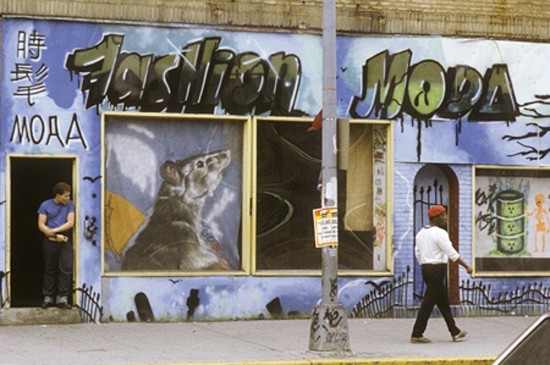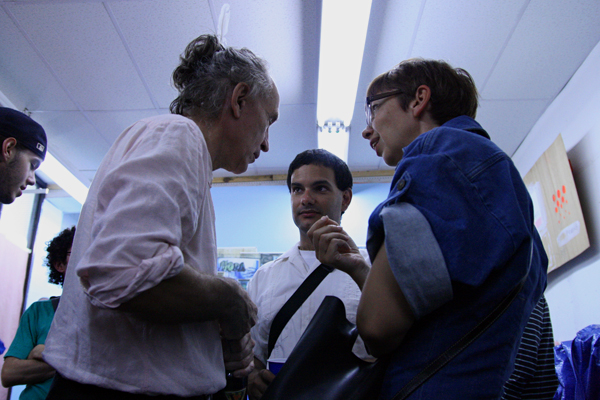
For a brief time Fashion Moda is reborn, uniting generations
Hundreds of people pass by Third Avenue and 147th Street each day without a second glance at the storefronts that house a nail salon, a hair braiding salon and, hidden from the street, a training school for security guards.
There’s no sign that 30 years ago, this was one of the hippest spots in New York City.
For 13 years, the graffiti covered storefront known as Fashion Moda, housed a collective of innovative artists, break-dancers, performers and other creative minds who painted, printed and sculpted, silk-screened T-shirts and sometimes just hung out, feeding on the energy each brought to the spot.
But for 11 days during September, Bronx-based multimedia artist Hatuey Ramos Fermin brought together the work of artists from the past and the present to pay homage to the former artist space and concept known as Fashion Moda.
The name incorporates the word for fashion in four languages–English, Spanish, Chinese and Russian. The idea behind Fashion Moda is that art can be created, shown and appreciated by anyone, anywhere.
So using the walls of On Time, the security guard training school, Fermin curated an exhibit at the former Fashion Moda with the work of 20 artists, five from the past and 15 from the present.
“We are doing a tribute to the space,” said Fermin. “It was a place for a lot of experimentation, street art and also fine art. A place where a lot of different artists met and got their names out.”
When he started Fashion Moda, Stefan Eins, fashion aimed to be trendsetting, something that was current and of the time–an appropriate concept, he believed, for his pioneering and chic art space.
Born in Austria, Eins founded Fashion Moda in 1978, fixing the broken windows in the front of the building and inviting both neighbors from the community and artist friends from downtown to use the space.
Eins added that graffiti artist, Keith Haring, was the first to design a T-shirt for Fashion Moda, and used Fashion Moda as a place to show his early work.
Craig Howard, who owns the On Time Security Guard Training School said he agreed to have his school transformed back into an art gallery for a few weeks because he remembered growing up in the area with friends who painted graffiti throughout the Bronx.
“I just thought it was something good to do and show people out there something different than the regular norm,” said Howard.
As part of the exhibition, one artist created a bust of Howard that now hangs on the wall above his desk and just over a colorful drawing by his 9-year-old daughter.
“I’m ecstatic,” said Howard with a smile about his sculpture. “Now when things go wrong I don’t really have to look in the mirror because I can look right up on the wall and see myself.”
Jeremy Nadel, an art teacher at a high school nearby, showed his work at Fashion Moda in 1986. He recalled Fashion Moda as a place that brought together the melting pot of New York City, a place where he felt safe.
The black and white photographs that hung on the walls of the retrospective, depicting a 1970’s boom box on a rickety park bench and of an oil drum fire reminded Nadel of a different era, a time he remembered when fireworks were lit the sky during the art shows at Fashion Moda and “regular folks” would listen to old school hip-hop music in front of the building.

Bronx Artist Libertad Guerra, who moved to Mott Haven five years ago from Brooklyn, said she too appreciates the history of Fashion Moda.
Among the paintings, the hooded sweatshirts covered with graffiti and a collage of Xeroxed prints, Guerra contributed a video installation piece that juxtaposed images from the Bronx with images from the movie Metropolis.
Guerra, who founded her own artist collective out of her home on Alexander Avenue called Spanic Attack, hosts poetry readings, film parties and even academic discussions about urban issues.
“Fashion Moda is very important–what it meant historically and the imitations that came out of it,” said Guerra, who studied art history at New York University. “Many of the things that define the canon of alternative art of the New York scene in the 70’s and 80’s were started by Fashion Moda.”
Another Bronx artist who became involved with Fashion Moda in the later years was, Miguelangel (Miky) Ruiz. He walked past the nail and hair salons twice before he realized where the retrospective was.
“What I like about it is how anonymous it is,” said Ruiz. “It’s a change of pace from the downtown scenes and the New York cliques.”
The exhibition at the one-time art space brought together the older generations of artists with the newer generations of artist.
And although Eins, with a feather in his hair, remembers fondly the artists and his work of Fashion Moda’s past, he remarks, “there is no reason to be nostalgic, because this is happening now.”
A version of this article appeared in the Fall 2009 issue of the Mott Haven Herald.

Great to see historical recognition for the role “The Moda” played in the lives of so many artists. I even did a summer internship there and got college credit for it at Wesleyan. Fashion Moda was way ahead of its time then and it is only proper that it is remembered for providing a creative forum for many people not just from the South Bronx but for the entire city during its tenure. Much respect to Stef and to the space he provided and protected for young creative minds.
[…] Blast from Mott Haven’s past recalls an artistic keystone […]
[…] Blast from Mott Haven’s past recalls an artistic keystone Share this:Share […]
[…] Blast from Mott Haven’s past recalls an artistic keystone […]